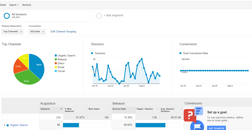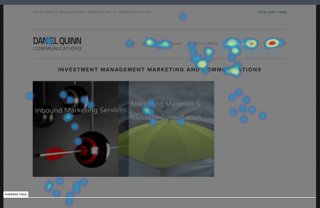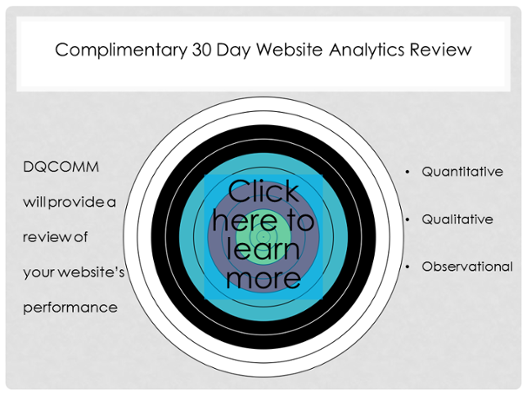Investment management websites are the undiscovered country of the asset management marketing world.
The reason, it seems, is because many investment managers are still equating digital marketing in 2017 with “internet marketing,” circa 1995.
There’s nothing sketchy or unethical about it; quite the opposite, in fact.
I also think that for most, the idea of investment management websites driving the marketing effort seems unlikely, thanks to the longer sales cycle that is characteristic of most of the industry.
Thus, the website shouldn’t be thought of as a sales tool, per se, but as a way to demonstrate professionalism, establish differentiation, and attract and nurture leads.
It's an example of the often-muddled distinction between investment management marketing vs. sales.
The website is the only marketing tool managers have that is universally available 24-7-365. So if you think about it, unless your site is optimized to work around the clock, drawing visitors and converting those visitors into leads, it is being underutilized.
But where’s the best place to start?
Making incremental improvements doesn’t require a full-scale commitment to Inbound Marketing for Investment Managers. (Wondering if you’re ready? Download our eBook on 5 Themes to Consider).
While it's more than worth your time to at least explore what Inbound Marketing is and what it can accomplish for your firm's long-term prospects, in the interim, here are 5 simple ways managers can start integrating their websites more closely into their marketing effort:
1. Install Google Analytics and review the data monthly
Ensuring Google Analytics is loaded on your website is the absolute least you can do to have even a token digital marketing effort.
GA tracks the ways in which visitors make their way to investment management websites, how long they’re there, and what they do while they are visiting.
A (totally non-exclusive and extremely abbreviated) list of items to monitor on a month-in, month-out basis are:
- Traffic Sources – This tell you how many of your visitors are coming to your site via search (Google, Bing, Yahoo, or another search engine) directly, or from other sources such as LinkedIn or Facebook.
If you are blogging, releasing thought leadership, and/or other online content, or if you are frequently in the media or engaged in public speaking events, tracking the result of your efforts through the lens of website traffic can help you to refine the ROI measurements of these activities. - Average time spent on site or page – A metric that is fairly straightforward: if yours is a content-heavy site, with lots of description on, say, the investment process page, but your visitors are averaging 10 seconds on the page, you might want to rethink you content strategy.
- Behavior: Site Content – This tells you the popularity of all pages on your site. This is key: if you have important content on a page, but your visitors aren’t finding it, you can make the appropriate changes to your site to make sure your audience is finding the items you want them to see.
But even if you aren't ready to track things quite so closely, just make an effort to look at your performance on a monthly basis. Compare it against the previous month or other similar periods in your firm's history.
Investment managers are data-driven, so you should still be able to glean some significant insight, even without any formal training or expertise in Google Analytics.
2. Install heat and scroll maps
I went over this in a recent Monday Morning Marketing Minute video and in a related blog post, but it bears  repeating here – having direct observational research on your how your website audience engages with your site is extremely important.
repeating here – having direct observational research on your how your website audience engages with your site is extremely important.
Click heatmaps and scroll heatmaps work by installing tracking code from a company such as Hotjar, which then allows you to view the areas of a web page that are getting the most (and fewest) clicks, and how far down people typically scroll on a page.
It’s important to know the things in which your audience is interested, as well as the things they don’t care about (or aren’t finding because they are placed disadvantageously on a page).
Armed with this data, investment management marketers can focus their message, organize their content, and manage the overall design efforts on the areas its audience seems to care most deeply about.
Similarly, session recordings actually record, in real time, the movement of a mouse as it tracks over a website, allowing you to see where they linger, where they click, and how they are navigating through your site.
3. Refresh the content, one page at a time
Website redesigns are a big commitment. Assuming your site is modern and functional, refreshing the content is always a good way to spruce things up a bit - think "paint job with new cabinets and countertops" rather than a gut rehab.
But even a content revamp can be a bit much. If that’s the case, work on one page at a time. Start with your homepage messaging, then work your way through philosophy, process, client service and so on until you have a fresh message.
Don’t forget to update your pitchbook, tear sheets, RFPs with your new messaging.
4. Firewall Your Premium Content
This also was the subject of a recent MMMM, and it’s one of the biggest website mistakes investment managers make.
Anything that has real value, beyond the basic helpfulness of your firm’s blog, should require the exchange of some basic contact information.
If you don’t firewall this content, you will have no idea who is downloading it. This means you can never follow up, can never know how they found your site, how you can also be of service, etc.
When someone fills out a form, they get the content in exchange for their contact information. This is vital digital marketing 101-type stuff for a few reasons:
- They are added to your CRM, and have, to a certain extent, pre-qualified themselves,
- They have agreed to receive additional communications from you,
- Most importantly, you are certain about one particular area of interest they have, and you can thus organize future communications around that interest.
So put some forms on your site and start “charging” for your content.
5. Offer Visitors Something of Value
Why do your clients work with you? What is it about your business that brought them to you in the first place, and why do they stay?
Knowing these things, think of some ways in which you can create “samples” or “trials” to get people to try your investment management services without committing.
If we were selling frozen yogurt, figuring out how to do this would be easy – stand outside your shop on a sunny Saturday afternoon & give away samples… literally.
Currently, I have the following offer:
With a bit of thought, you can do the same thing: is there a part of your onboarding process that clients love, but doesn’t ask much of you at all? Is your portfolio review process for new clients interesting and a point of differentiation?
If so, or if there’s something else in your business that clients deeply value and is a point of differentiation, then create an offer around that item. Give prospects a taste of what you offer and how you are different.
In sum…
While reconceiving your entire marketing strategy, with the website at its center, is a great idea, it does ask a big commitment, and something of a leap of faith.
Making incremental changes first, then analyzing the effct of those changes can help PMs and firm leadership to become more comfortable with digital marketing, and thus smooth the way for a more committed buy-in down the road.



